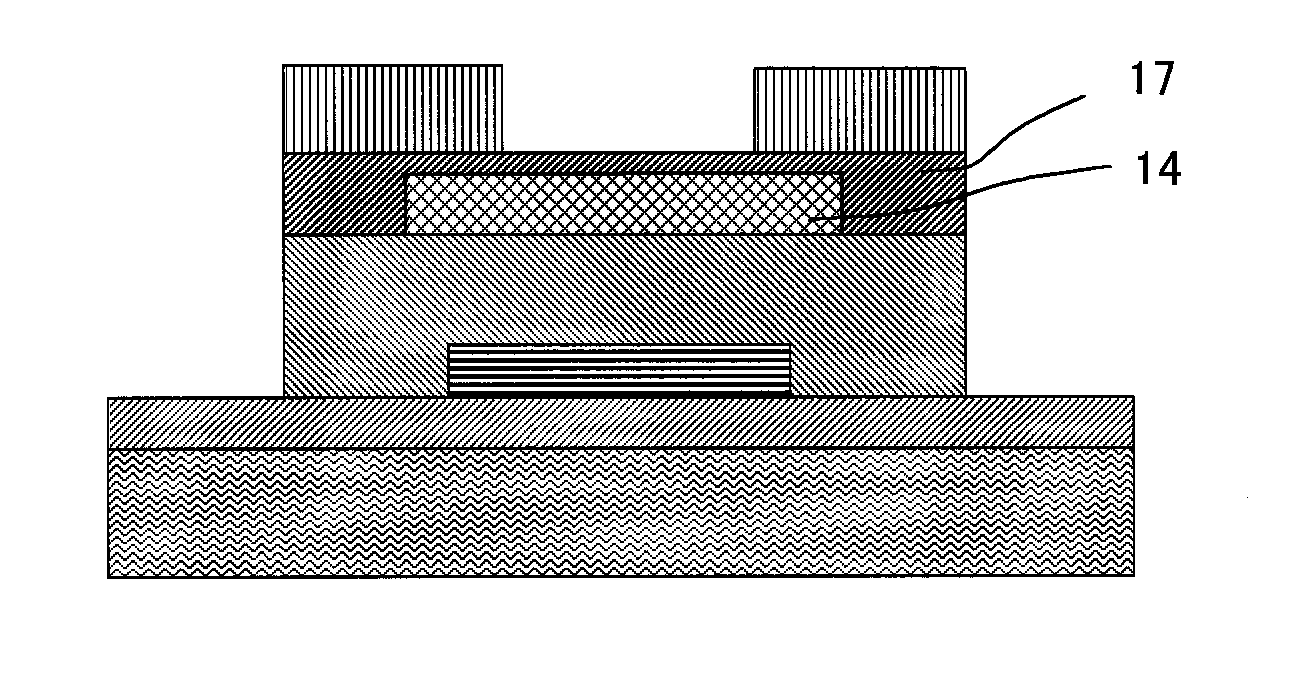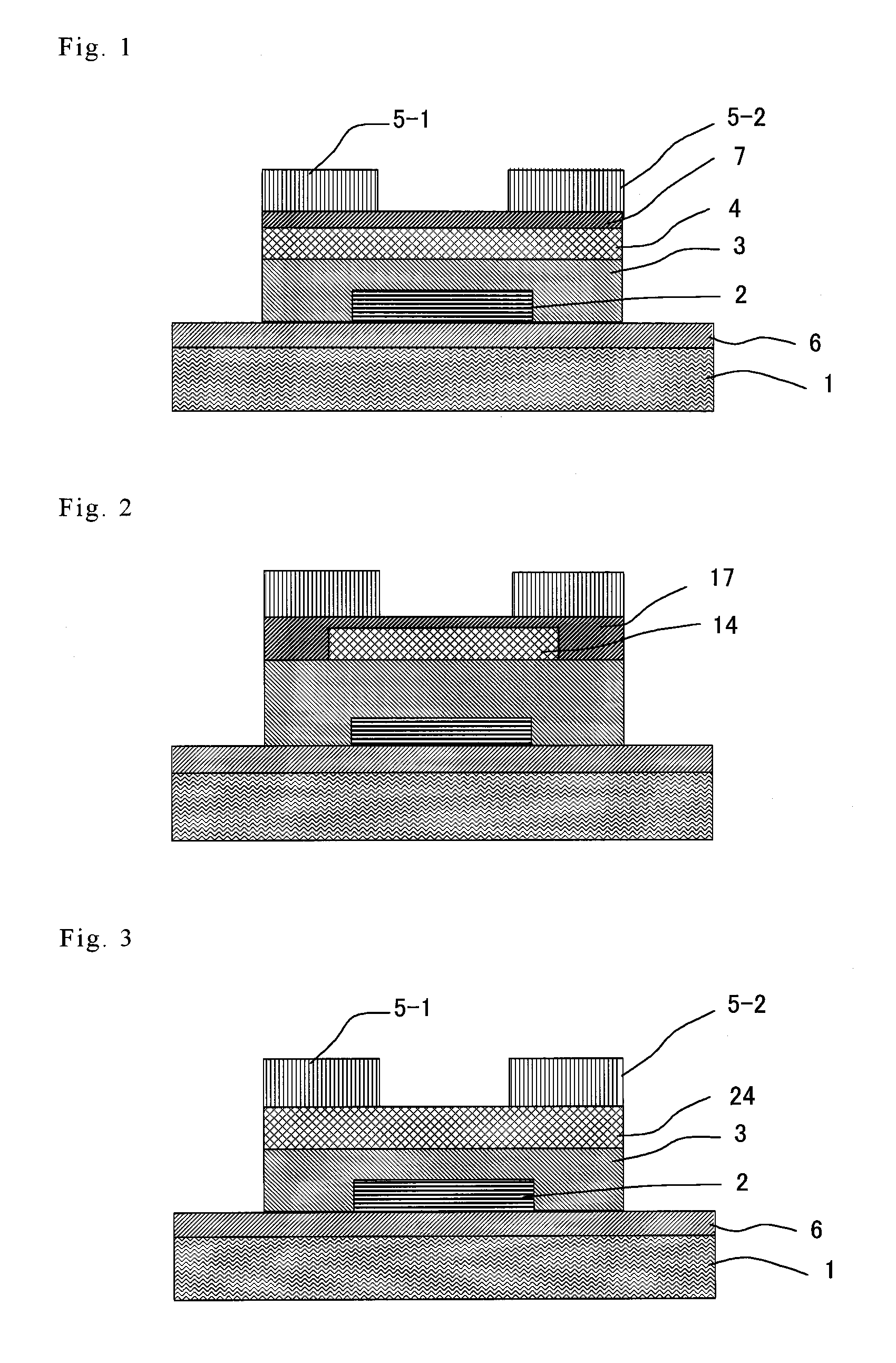Thin film field effect transistor and display
a field effect transistor and thin film technology, applied in the direction of solid-state devices, electric lighting sources, electric light sources, etc., can solve the problems of poor heat resistance, low heat resistance, and difficulty in forming transistors directly on resin substrates
- Summary
- Abstract
- Description
- Claims
- Application Information
AI Technical Summary
Benefits of technology
Problems solved by technology
Method used
Image
Examples
example 1
1. Preparation of TFT Element
1) Preparation of Inventive TFT Element
[0295]
[0296]A substrate and a gate electrode were prepared as follows.
[0297]An N-type Si substrate having a thickness of 0.5 mm (manufactured by Jemco Co., Ltd., electric resistance: from 1 Ωcm to 3.5 Ωcm) was used as a conductive N-type substrate, and this is used as both the substrate and the gate electrode.
[0298]
[0299]Next, on the gate electrode, the following gate insulating layer was formed.
[0300]Gate insulating layer: a gate insulating layer was provided by performing RF magnetron sputtering vacuum deposition of SiO2 (conditions: target of SiO2, temperature for film formation of 54° C., flow rates of sputtering gas Ar / O2=12 sccm / 2 sccm, RF power of 400 W, and film-forming pressure of 0.4 Pa) to form a layer having a thickness of 100 nm. Patterning of the SiO2 gate insulating layer was performed using a shadow mask during sputtering.
[0301]
[0302]Active layer 1: on the gate insulating layer, RF magnetron sputteri...
example 2
[0329]TFT elements were prepared in a similar manner to that in Example 1, except that a barrier-attached film having the following insulating layer, which has a function of barrier, on both sides of a polyethylene naphthalate film (having a thickness of 100 μm) was used instead of the n-Si substrate in Example 1.
[0330]Insulating layer: SiON was deposited to give a thickness of 500 nm. For the deposition of SiON, an RF magnetron sputtering deposition method (conditions for sputtering: target of Si3N4, RF power of 400 W, flow rates of gas Ar / O2=12 sccm / 3 sccm, and film-forming pressure of 0.45 Pa) was applied.
[0331]The obtained elements were evaluated in a similar manner to that in Example 1. As a result, the inventive elements exhibited a small shift quantity of threshold voltage, similar to the results in Example 1.
example 3
1. Preparation of Organic EL Display
[0332](Preparation of Organic EL Element Part)
[0333]1) Formation of Lower Electrode
[0334]As a substrate, the above barrier-attached film including an insulating layer having a function of barrier on both sides of a polyethylene naphthalate film was used. On the substrate, indium-tin oxide (which is referred to hereinafter as ITO) was deposited at a thickness of 150 nm to form an anode.
[0335]2) Formation of Organic Layer
[0336]After cleaning, a hole injection layer, a hole transport layer, a light-emitting layer, a hole blocking layer, an electron transport layer and an electron injection layer were disposed in this order.
[0337]The composition of each layer is as follows. Each layer was provided by resistance heating vacuum deposition.
[0338]Hole injection layer: a layer containing 4,4′,4″-tris(2-naphthylphenylamino)triphenylamine (which is referred to as 2-TNATA) and 2,3,5,6-tetrafluoro-7,7,8,8-tetracyanoquinodimethane (which is referred to as F4-TC...
PUM
 Login to View More
Login to View More Abstract
Description
Claims
Application Information
 Login to View More
Login to View More - R&D
- Intellectual Property
- Life Sciences
- Materials
- Tech Scout
- Unparalleled Data Quality
- Higher Quality Content
- 60% Fewer Hallucinations
Browse by: Latest US Patents, China's latest patents, Technical Efficacy Thesaurus, Application Domain, Technology Topic, Popular Technical Reports.
© 2025 PatSnap. All rights reserved.Legal|Privacy policy|Modern Slavery Act Transparency Statement|Sitemap|About US| Contact US: help@patsnap.com



